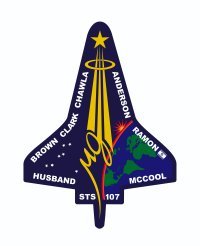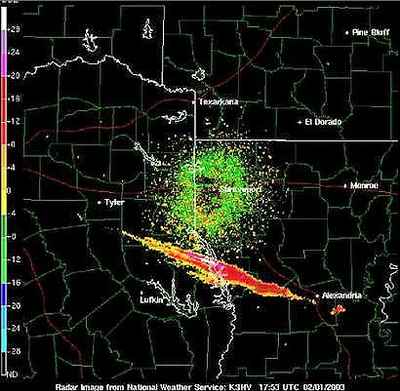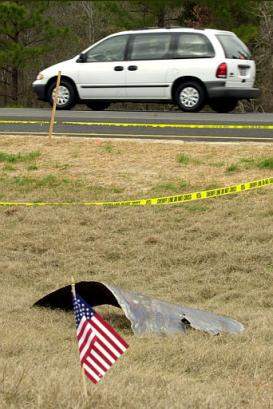Tue, Feb 25, 2003
 The Columbia Accident Investigation Board (CAIB)
Advanced Sightings Team is working to pinpoint the location of
hardware that may have separated from the Space Shuttle Columbia
early in its final path over the western United States.
The Columbia Accident Investigation Board (CAIB)
Advanced Sightings Team is working to pinpoint the location of
hardware that may have separated from the Space Shuttle Columbia
early in its final path over the western United States.
The team is bringing together data from the National Aeronautics
and Space Administration (NASA), the public, Department of Defense
(DOD), Department of Energy (DOE), the National Oceanic and
Atmospheric Administration (NOAA), the United States Geologic
Survey (USGS) and all other sources of valuable information that
become available. The collaboration of all these organizations has
been outstanding. The team is piecing together the information from
these sources to learn as much as possible about anomalous
conditions during the entry of Columbia.
Examples of information that is being brought to bear are:
- On orbit photography and analysis- DOD
- Radar searches- DOD
- Infrasonic data- DOE, NOAA
- Tracking of possible on orbit object from Columbia 1/17/03 and
analysis- DOD
- Launch Analysis- DOD
- Identification of entry shedding events- DOD
- Kirtland photo analysis- DOD

This team is analyzing video footage turned in by space flight
enthusiasts and other sources of information to document exactly
when these events occurred. The earliest shedding of Shuttle
hardware may well have been documented by videos taken near the
California coast. The team identifies anomalous events from the
video data and correlates them to the entry timeline.
 Analysts calculate the exact time and angles of
the observation by determining exactly where the videos were taken
from and by identifying planets or star fields in the background.
The team calculates trajectories to predict probabilities of where
the debris may have fallen to Earth by estimating properties of
possible debris from the video and incorporating known atmospheric
and wind data. Radar data is then retrieved and investigated to
search for specific
Analysts calculate the exact time and angles of
the observation by determining exactly where the videos were taken
from and by identifying planets or star fields in the background.
The team calculates trajectories to predict probabilities of where
the debris may have fallen to Earth by estimating properties of
possible debris from the video and incorporating known atmospheric
and wind data. Radar data is then retrieved and investigated to
search for specific
signatures. This process serves to drastically reduce the area that
must be searched.
The Advanced Sightings Team is making significant progress in
accurately characterizing possible debris events. They are in the
process of making the subsequent calculations and taking the next
steps. The most western find is still not far from Fort Worth,
Texas. Using this process and other possible means, we hope debris
discovered farther west would help to unravel the mystery of why
this tragedy occurred.
The CAIB and NASA continue to encourage all who have videos or
who identify potential Columbia hardware to contribute to the
success of this investigation by contacting us as soon as possible.
If you find hardware, you should contact local authorities. Avoid
touching it in case it is ontaminated with toxic substances.
More News
Aero Linx: Transport Canada We are a federal institution, leading the Transport Canada portfolio and working with our partners. Transport Canada is responsible for transportation p>[...]
Gross Navigation Error (GNE) A lateral deviation from a cleared track, normally in excess of 25 Nautical Miles (NM). More stringent standards (for example, 10NM in some parts of th>[...]
From AirVenture 2017 (YouTube Edition): Flight-Proven Booster On Display At AirVenture… EAA AirVenture Oshkosh is known primarily as a celebration of experimental and amateu>[...]
Aircraft Parachute System (CAPS) Was Deployed About 293 Ft Above Ground Level, Which Was Too Low To Allow For Full Deployment Of The Parachute System Analysis: The day before the a>[...]
Also: 48th Annual Air Race Classic, Hot Air Balloon Fire, FAA v Banning 100LL, Complete Remote Pilot The news Piper PA-18 Super Cub owners have been waiting for has finally arrived>[...]
 ANN's Daily Aero-Linx (06.29.25)
ANN's Daily Aero-Linx (06.29.25) ANN's Daily Aero-Term (06.29.25): Gross Navigation Error (GNE)
ANN's Daily Aero-Term (06.29.25): Gross Navigation Error (GNE) Classic Aero-TV: Anticipating Futurespace - Blue Origin Visits Airventure 2017
Classic Aero-TV: Anticipating Futurespace - Blue Origin Visits Airventure 2017 NTSB Final Report: Cirrus SR22
NTSB Final Report: Cirrus SR22 Airborne Affordable Flyers 06.26.25: PA18 Upgrades, Delta Force, Rhinebeck
Airborne Affordable Flyers 06.26.25: PA18 Upgrades, Delta Force, Rhinebeck





